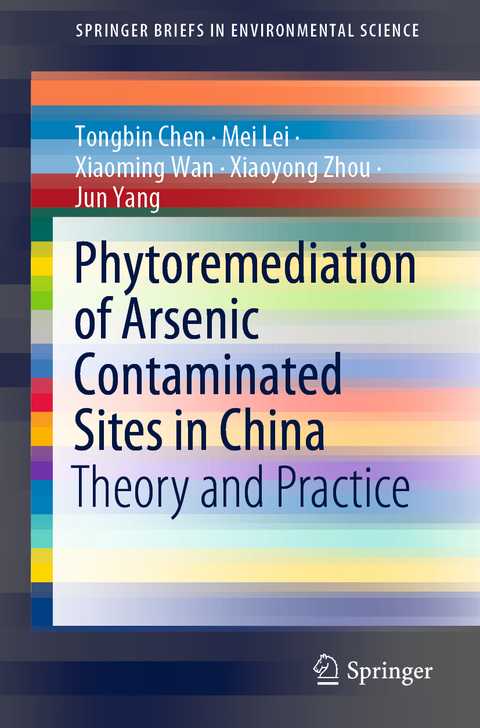
Phytoremediation of Arsenic Contaminated Sites in China
Springer Verlag, Singapore
978-981-15-7819-9 (ISBN)
Last name: Chen First name: Tongbin Title(s): Professor Affiliation: Institute of Geographic Sciences and Natural Resources Research, Chinese Academy of Sciences Address/phone/fax/e-mail/home page: No. 11 (A) Datun Chaoyang Beijing 100101 Last name: Lei First name: Mei Title(s): Professor Affiliation: Institute of Geographic Sciences and Natural Resources Research, Chinese Academy of Sciences Address/phone/fax/e-mail/home page: No. 11 (A) Datun Chaoyang Beijing 100101 Last name: Wan First name: Xiaoming Title(s): Assistant Professor Affiliation: Institute of Geographic Sciences and Natural Resources Research, Chinese Academy of Sciences Address/phone/fax/e-mail/home page: No. 11 (A) Datun Chaoyang Beijing 100101 Last name: Zhou First name: Xiaoyong Title(s): Assistant Professor Affiliation: Institute of Geographic Sciences and Natural Resources Research, Chinese Academy of Sciences Address/phone/fax/e-mail/home page: No. 11 (A) Datun Chaoyang Beijing 100101< Last name: Yang First name: Jun Title(s): Assistant Professor Affiliation: Institute of Geographic Sciences and Natural Resources Research, Chinese Academy of Sciences Address/phone/fax/e-mail/home page: No. 11 (A) Datun Chaoyang Beijing 100101 Prof Chen is the director of Lab of Environmental Chemistry and Healthiness in Land Surface, and director of Center of Environmental Remediation, Institute of Geographic Sciences and Resources Research, Chinese Academy ofSciences (CAS). He is also the visited professor of 10 universities and institutes, including the Graduate School of CAS, the Sun Yat-sen University, and the State Laboratory of Beijing Electron Positron Collider. Now Prof. Chen has served on Plant Nutrition and Fertilizer Society of China (PNFSC) as the Chairman of Soil Remediation Division, and served on the Soil Science Society of China (SSSC) as the Chairman of Soil Pollution Division. He has been in charge of Technology Committee of National Agricultural Development Center, and he is also the Deputy Director of Pollution Ecology Committee of China Ecology Society. Prof Chen is currently member of the editorial board of 18 publications, including Chinese Science Bulletin, Journal of Environmental Sciences, Journal of Agronomy Science, and Pedosphere. He is the corresponding author of more than 200 original scientific papers, 8 chapters in books. Seventeen patents have been applied by him, among which 12 patents have been awarded. Professor Chen has been pursuing research on environment remediation, assessment of regional environment quality, and resource reuse of organic waste for more than 20 years. His research group has actively involved in following fields: l Phytoremediation and bioremediation of contaminated land A 'green' technology that harnesses the power of plants and microbes to remove metals/metalloids from Brownfields, and also to degrade organic contaminants in situ on these sites. And finally revegetation of contaminated and degraded soils, mineral wastes and Brownfield sites. Prof. Chen screened out the first As hyperaccumulator Pteris vittata L., and established the first international in situ remediation project for As-contaminated land. During last ten years, his group solved the key problems of phytoremediation technique. About 40 hectares Brownfields in three provinces of China have been under cleanup by the phytoremediation techniques developed by Prof. Chen’s group. l Health risk assessment of environment pollution Professor Chen proposed the theories and methods on monitoring the heavy metals in soil, vegetables and staple food at a regional scale for 6 provinces and cities, and mapped the distribution of heavy metals. Following his ideas, the research group established the Early Alarming System of Risk and Database Management System of Heavy Metals in Soils and Vegetables from Beijing based on GIS. l Composting of animal wastes and sewage sludge Prof. Chen also developed the auto-control system and technologies for organic solid waste composting. Now his group’s had already established 5 composting projects for 50t sewage sludge per day. After composting, the solid wastes are applied for land use as fertilizers. Recently, this auto-control system was proved effective for fast biodegrading the organic contaminations of Brownfields.
Arsenic hyperaccumulator Pteris Vittata L. and its arsenic accumulation.- Arsenic hyperaccumulation mechanisms: absorption, transportation and detoxification.- Establishment of phytoremediation technology for arsenic contaminated sites.- Application of phytoremediation technology to typical mining sites in China.- Enhancement of arsenic removal in phytoremediation of arsenic contaminated soils.
| Erscheinungsdatum | 25.09.2020 |
|---|---|
| Reihe/Serie | SpringerBriefs in Environmental Science |
| Zusatzinfo | 30 Illustrations, color; 28 Illustrations, black and white; VI, 82 p. 58 illus., 30 illus. in color. |
| Verlagsort | Singapore |
| Sprache | englisch |
| Maße | 155 x 235 mm |
| Themenwelt | Naturwissenschaften ► Biologie ► Ökologie / Naturschutz |
| Naturwissenschaften ► Chemie ► Technische Chemie | |
| Naturwissenschaften ► Geowissenschaften ► Geologie | |
| Technik ► Umwelttechnik / Biotechnologie | |
| Weitere Fachgebiete ► Land- / Forstwirtschaft / Fischerei | |
| ISBN-10 | 981-15-7819-2 / 9811578192 |
| ISBN-13 | 978-981-15-7819-9 / 9789811578199 |
| Zustand | Neuware |
| Haben Sie eine Frage zum Produkt? |
aus dem Bereich


